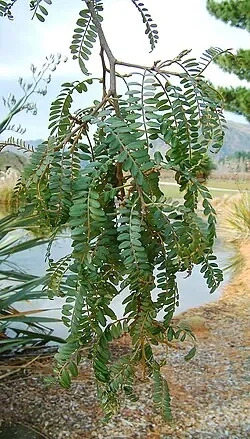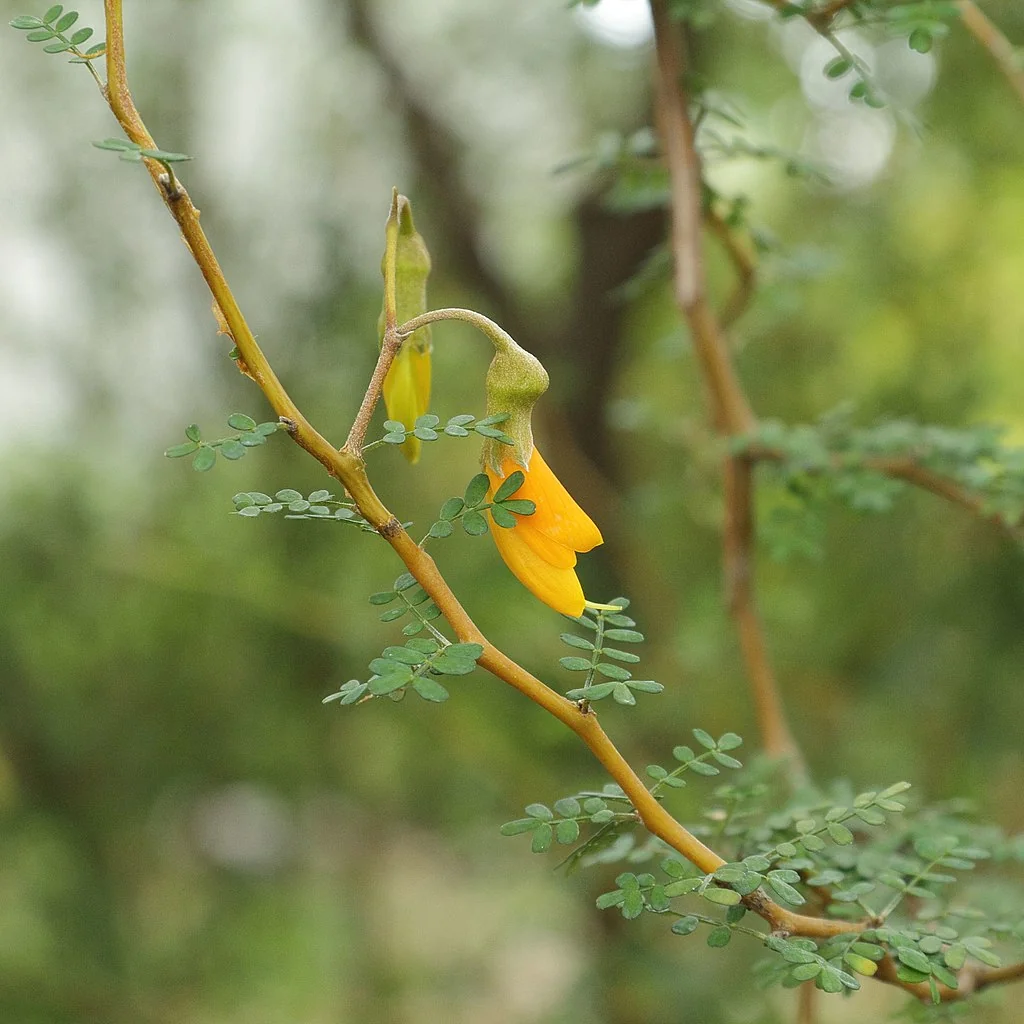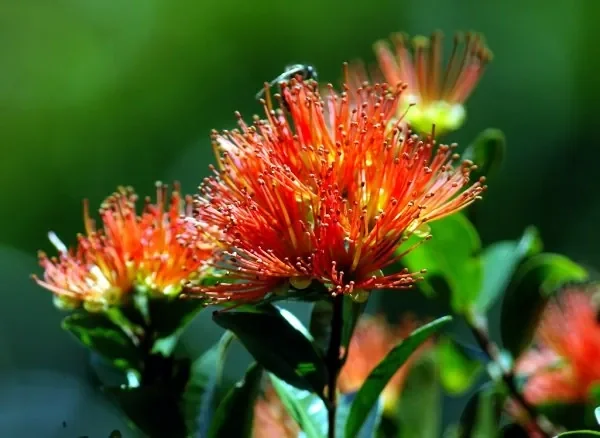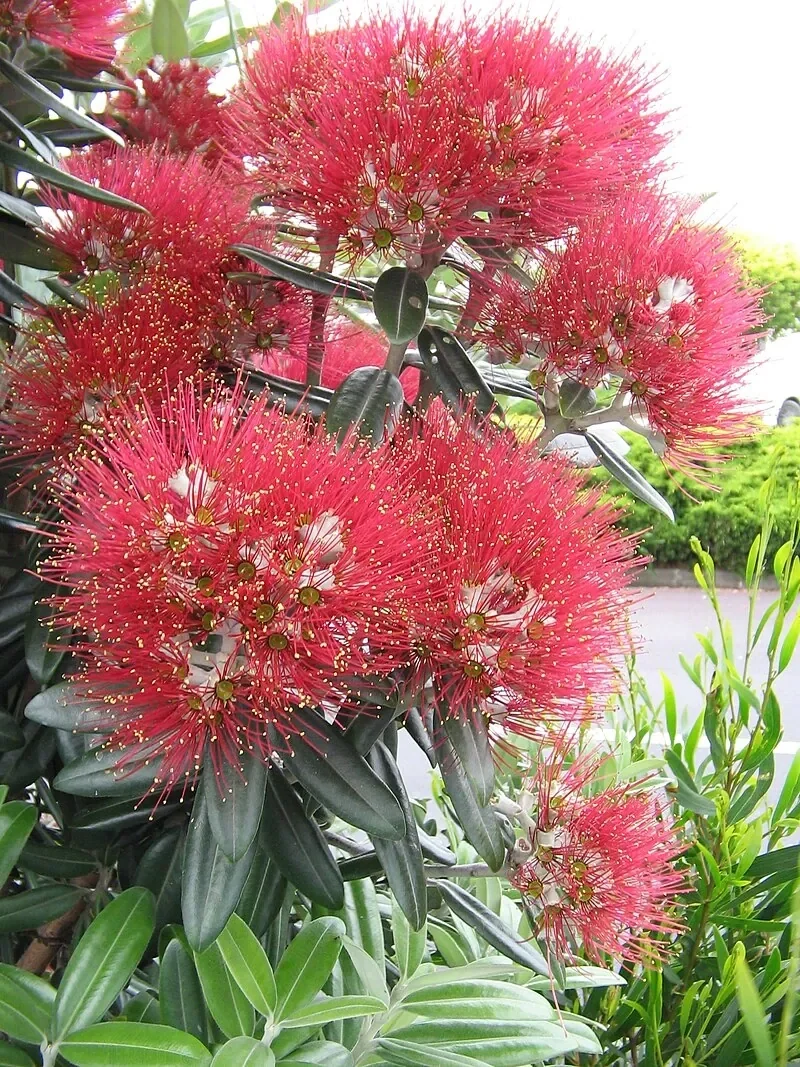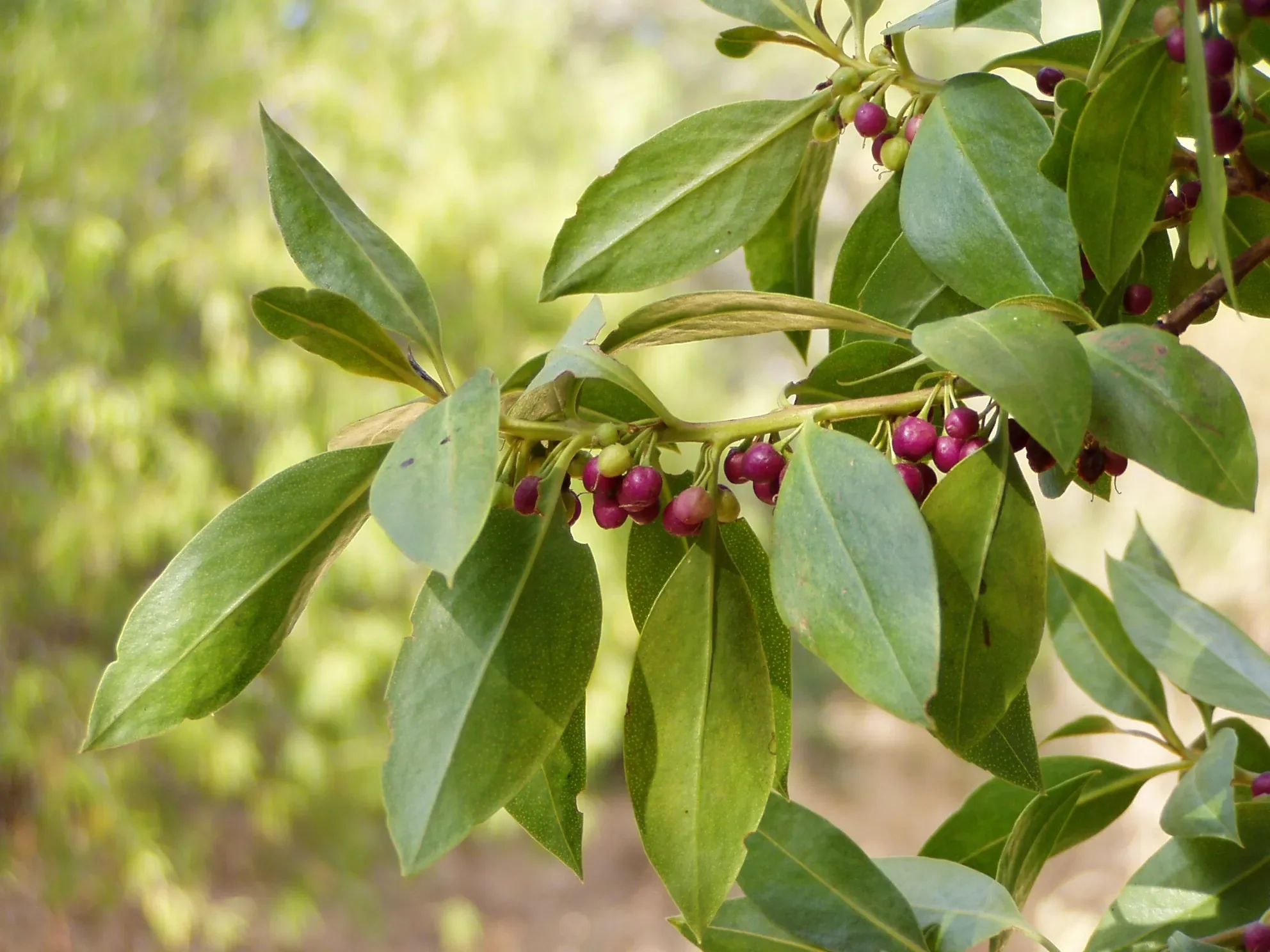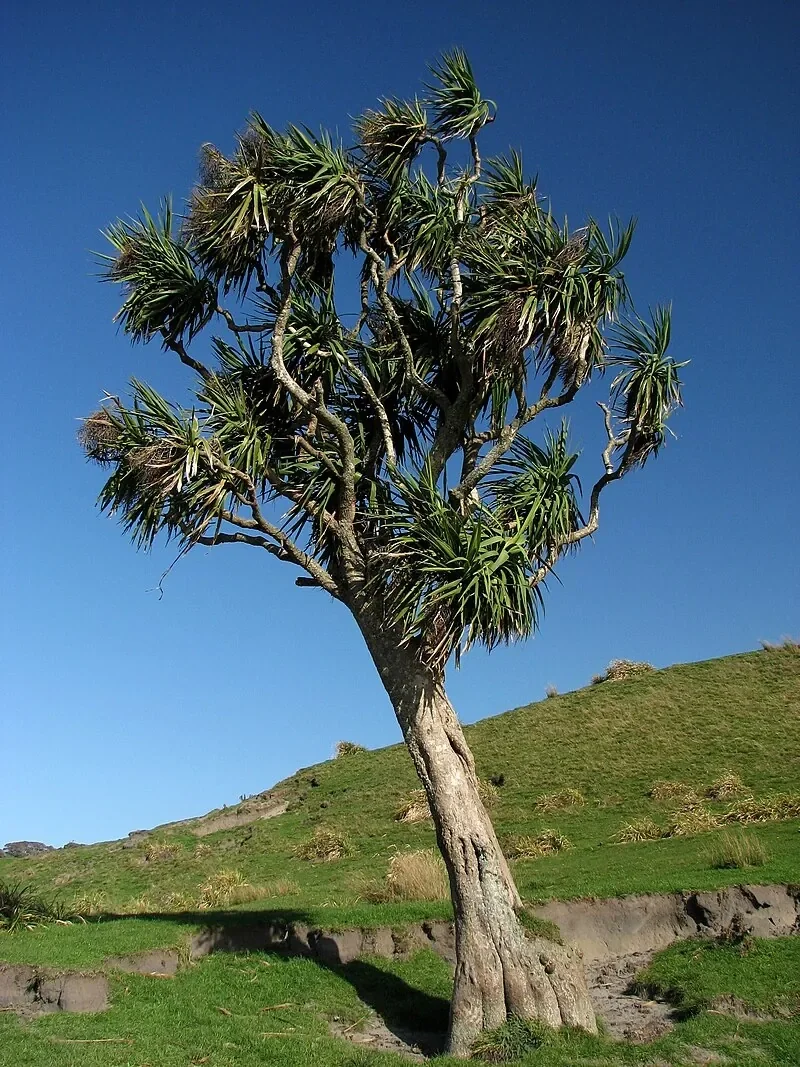
Coastal Kowhai
Sophora chathamica
The coastal kowhai (scientific name: Sophora chathamica) is one of New Zealand's most distinctive and culturally significant native trees. This remarkable species stands apart from other kowhai by producing unique cream-coloured flowers instead of the typical bright yellow blooms, and by lacking the distinctive divaricating juvenile stage common to most kowhai species. Originally distributed along coastal areas of the northern North Island, this species has fascinating historical connections to Māori migration and traditional planting practices. Today, coastal kowhai serves as both a symbol of New Zealand's natural heritage and an important component of restoration projects throughout the country.

Plant Description
Sophora chathamica forms a beautiful small to medium-sized tree reaching heights of 6-10 metres with a spreading crown up to 4 metres wide. The species exhibits a distinctive growth pattern, developing straight into its mature form without the tangled, divaricating juvenile stage characteristic of most other kowhai species.
The complex leaves are particularly notable, growing 100-150mm long with leaflets measuring 6-16mm long by 4-8mm wide. These leaflets display a unique overlapping arrangement, becoming progressively smaller toward the leaf tip, and are broadly elliptic to orbicular in shape. The entire plant is covered with moderate to dense soft hairs, giving it a distinctive silvery-green appearance that helps it thrive in coastal conditions.
Most remarkably, coastal kowhai produces clusters of drooping cream-coloured flowers rather than the bright yellow blooms associated with other kowhai species. These flowers appear from mid-winter through to November, making this an early-flowering species that provides crucial nectar when few other plants are in bloom. The flowers develop into distinctive dry, ridged seed pods 50-180mm long containing hard yellow seeds.
Quick Facts
| Scientific Name | Sophora chathamica |
|---|---|
| Height | 6-10m |
| Spread | 3-4m |
| Water Needs | Moderate |
| Light | Full sun to partial shade |
| Frost Tolerance | Hardy |
| Salt Tolerance | Excellent |
| Growth Rate | Moderate |
| Lifespan | Long-lived (100+ years) |
Climate Best Suited to
Coastal kowhai (Sophora chathamica) thrives in temperate coastal climates and demonstrates exceptional tolerance to salt spray and coastal winds. The species shows good cold tolerance and can withstand moderate frosts, making it suitable for cultivation throughout most of New Zealand except the most extreme alpine environments. Its natural adaptation to coastal conditions makes it particularly valuable for shelter plantings and erosion control in exposed locations.
Regional Suitability
| City | Climate Suitability |
|---|---|
| Whangārei | Ideal |
| Auckland | Ideal |
| Hamilton | Ideal |
| Tauranga | Ideal |
| Rotorua | Ideal |
| Gisborne | Ideal |
| New Plymouth | Ideal |
| Napier | Ideal |
| Whanganui | Ideal |
| Palmerston North | Ideal |
| Wellington | Ideal |
| Nelson | Ideal |
| Christchurch | Good |
| Dunedin | Good |
| Invercargill | Moderate |
Plant Habitat
In its natural environment, Sophora chathamica primarily inhabits coastal forest margins, cliff faces, and banks overlooking estuarine rivers or coastal inlets. The species shows remarkable adaptation to challenging coastal conditions, thriving on exposed sites where salt spray, strong winds, and variable soil conditions create harsh growing environments for many other plants.
The natural range extends along the western coast of the North Island from Te Paki in the far north to the Tongaporutu River in north Taranaki. On the eastern coast, it occurs naturally from about Thames northward, with particularly abundant populations around Auckland, the Hauraki Gulf, and from Port Waikato south to Kawhia. The species occasionally occurs in swamp forest environments, demonstrating its adaptability to varying moisture conditions.
Coastal kowhai serves as an important component of coastal forest ecosystems, often forming part of the transitional zone between open coastal areas and established forest. Its ability to establish on steep, unstable sites makes it valuable for natural erosion control, while its early flowering provides crucial nectar resources for native birds during winter and early spring when few other food sources are available.
Plant Conservation
Sophora chathamica is classified as "At Risk - Naturally Uncommon" under New Zealand's threat classification system. While the species appears secure within its natural range, its conservation faces several significant challenges that require ongoing attention and management.
The primary conservation concern involves genetic integrity and hybridization threats. Widespread planting of kowhai species outside their natural ranges, combined with the use of hybrid material in revegetation projects, poses risks to pure genetic lines of S. chathamica. The common practice of selling mixed kowhai species in nurseries, often incorrectly labeled, creates additional problems and can lead to genetic contamination of wild populations.
Conservation efforts focus on protecting existing natural populations, particularly those in coastal reserves and forest remnants. The species benefits from habitat protection initiatives that maintain coastal forest connectivity and prevent development pressure on critical coastal sites. Seed collection for conservation purposes must be carefully managed to ensure genetic authenticity and prevent further hybridization issues.
Growing Requirements
Soil Requirements
Coastal kowhai (Sophora chathamica) requires well-drained soils and cannot tolerate waterlogged conditions. The species shows remarkable adaptability to soil types, thriving in sandy coastal soils, clay loams, and even relatively poor soils once established. Good drainage is absolutely essential, as the plant's nitrogen-fixing root nodules are sensitive to soil saturation.
- Essential requirement for well-drained soils - will not survive waterlogging
- Adapts to sandy, loamy, or clay soils provided drainage is adequate
- Tolerates poor, low-fertility soils due to nitrogen-fixing capabilities
- Prefers neutral to slightly alkaline pH but adapts to mildly acidic conditions
- Excellent tolerance for coastal soils with salt content
Light Requirements
Sophora chathamica performs best in full sun positions where it develops its characteristic dense, well-formed crown and produces abundant flowering. The species tolerates partial shade but may become somewhat stretched and spindly as branches extend toward available light. Adequate light exposure is particularly important for flower production and overall plant vigor.
- Optimal growth and flowering in full sun positions
- Tolerates partial shade but with reduced density and flowering
- At least 6 hours of direct sunlight daily recommended
- Shelter from extreme wind beneficial during establishment
Water Requirements
Water requirements are moderate, with the species showing good drought tolerance once fully established. Regular watering during the first few years helps develop a strong root system, after which the plant becomes increasingly self-sufficient. The species handles both seasonal dry periods and occasional wet conditions, though prolonged waterlogging must be avoided.
- Moderate water needs with good drought tolerance when established
- Regular watering essential during first 2-3 years for establishment
- Deep, infrequent watering preferred over frequent shallow watering
- Handles seasonal dry periods well once mature
- Mulching helps retain soil moisture and suppress weeds
Planting Guide
Select a planting site with excellent drainage and good sun exposure. The location should have some shelter from extreme winds during the establishment period, though mature trees are very wind tolerant. Coastal kowhai is particularly well-suited to challenging sites including slopes, coastal exposures, and areas with poor soils where other trees might struggle.
Prepare the planting site by ensuring adequate drainage - this cannot be overstated as the primary requirement for success with this species. If drainage is questionable, consider creating a raised planting area or installing drainage improvements. The planting hole should be dug to the same depth as the container but twice as wide to encourage root establishment.
Plant during cooler months (autumn to early spring) to reduce establishment stress. Water thoroughly after planting and apply a thick organic mulch around the base, keeping mulch away from the trunk. Regular watering during dry periods for the first two seasons will help establish a strong root system and ensure successful establishment.
Ecological Role
Sophora chathamica plays a vital role in New Zealand's coastal ecosystems, providing essential nectar resources for native birds during winter and early spring when few other plants are flowering. Tūī, bellbirds, and waxeyes rely heavily on kowhai nectar, while kereru feed on both the flowers and leaves, helping to maintain these important native bird populations.
As a nitrogen-fixing legume, coastal kowhai contributes to soil fertility improvement in coastal environments where nutrient levels are often limited. The specialized root nodules host nitrogen-fixing bacteria that convert atmospheric nitrogen into forms available to other plants, gradually enriching the soil and supporting the establishment of other native species in restoration sites.
The species serves as a host plant for the native kowhai moth (Uresiphita polygonalis maorialis), whose caterpillars feed specifically on kowhai foliage. This relationship demonstrates the intricate ecological connections that have evolved around New Zealand's endemic plant species and highlights the importance of maintaining genetic diversity within kowhai populations to support native insect communities.
Uses & Significance
Garden Uses
Coastal kowhai (Sophora chathamica) is highly valued in landscape design for its distinctive cream-colored flowers, excellent coastal tolerance, and manageable size. The species is particularly suitable for coastal gardens, shelter plantings, and as a specimen tree where its unique flowering display can be appreciated. Its early flowering habit makes it invaluable for providing winter and early spring interest in the garden.
- Outstanding specimen tree for coastal and exposed gardens
- Excellent for shelter belts and wind protection in challenging sites
- Valuable for erosion control on slopes and unstable coastal sites
- Essential for native bird habitat gardens providing winter nectar
- Suitable for restoration projects in coastal forest environments
The cultural significance of coastal kowhai extends far beyond its natural distribution, with strong evidence suggesting that Māori deliberately transported this species to new locations as part of their traditional plant cultivation practices. The presence of S. chathamica in Wellington and the Chatham Islands is believed to result from plantings by North Island iwi (Ngati Mutunga and Ngati Tama) who valued the species for its spiritual and practical importance.
- Sacred tree in Māori culture symbolizing wisdom, knowledge, and connection to land
- Deliberately planted by Māori as they migrated to new territories
- Traditional source of yellow dye from flowers, seedpods, and bark
- Wood used for tools, weapons, and construction including taiaha and fish hooks
- Bark used medicinally for treating various ailments and injuries
Ecological Value
The ecological value of coastal kowhai extends throughout New Zealand's coastal ecosystems, where it serves as a keystone species supporting diverse wildlife communities. Its early flowering habit provides critical nectar resources during the harshest months of the year, while its nitrogen-fixing capabilities help improve soil conditions for other native plants.
- Critical early-season nectar source for native birds during winter months
- Nitrogen-fixing capabilities improve soil fertility in coastal environments
- Essential host plant for native kowhai moth caterpillars
- Pioneer species valuable for coastal forest succession
- Natural erosion control and slope stabilization in coastal areas
Landscaping Uses
Sophora chathamica offers exceptional landscaping potential, particularly in challenging coastal and exposed sites where many other trees struggle to establish. Its compact size, attractive form, and unique cream-colored flowers make it an excellent choice for both formal and informal garden settings, while its tolerance for poor soils and harsh conditions extends planting opportunities to difficult sites.
The species works particularly well in contemporary native garden designs, where its architectural form and distinctive flowering habit create strong focal points. Mass plantings of coastal kowhai can create stunning seasonal displays, while individual specimens work well as feature trees in smaller gardens. The tree's moderate size makes it suitable for urban environments where space constraints limit the use of larger forest trees.
For restoration projects, coastal kowhai serves as an excellent pioneer species that can establish quickly on difficult sites and begin improving conditions for other native plants. Its ability to thrive in exposed coastal locations makes it invaluable for dune stabilization and coastal protection projects, while its nitrogen-fixing capabilities contribute to long-term site rehabilitation success.
Seasonal Care Calendar
Spring
Spring marks the continuation of coastal kowhai's extended flowering period, with peak bloom typically occurring during September and October. New growth emerges after flowering, and this is an excellent time for planting new specimens. The soil is warming but still retains good moisture levels, providing ideal establishment conditions.
- Peak flowering period continues with abundant cream-colored blooms
- Ideal time for planting new specimens with warming soil temperatures
- Apply organic fertilizer if desired, though usually not necessary
- Begin regular watering schedule for newly planted trees
- Native birds most active around flowers - excellent time for observation
Summer
Summer is the main growing season for coastal kowhai, with vigorous shoot extension and leaf development. Flowering typically concludes by mid-summer, followed by seed pod development. Regular watering becomes important during hot, dry periods, particularly for younger trees still establishing their root systems.
- Active growing season with vigorous shoot and foliage development
- Seed pods develop and mature throughout summer months
- Regular watering important during hot, dry spells
- Mulching helps conserve soil moisture and moderate soil temperature
- Good time for any necessary pruning of young trees
Autumn
During autumn, coastal kowhai begins preparing for the next flowering cycle while seed pods reach maturity and split to release seeds. This is another excellent planting season, with cooling temperatures and increased rainfall providing good establishment conditions. Seed collection can be undertaken for propagation purposes.
- Seed pods mature and split to release viable seeds
- Excellent season for planting with favorable temperature and moisture conditions
- Ideal time for seed collection for propagation projects
- Natural leaf drop occurs in response to decreasing temperatures
- Reduce watering frequency as growth rate slows
Winter
Winter is when coastal kowhai truly shines, beginning its remarkable early flowering display that can start as early as mid-winter. This extended flowering period distinguishes the species from other kowhai and makes it invaluable for providing nectar during the harshest months of the year when few other plants are blooming.
- Early flowering begins, often starting in mid-winter
- Critical nectar source for native birds during harsh winter months
- Minimal watering required due to reduced growth activity
- Natural dormancy period with reduced fertilizer needs
- Suitable time for structural pruning if required
When to Prune and How Much
Coastal kowhai (Sophora chathamica) generally requires minimal pruning to maintain its naturally attractive form and health. The species develops a well-balanced crown naturally and benefits most from light maintenance pruning rather than heavy structural modification. Any pruning should focus on enhancing the tree's natural form rather than fighting against it.
- Remove dead, damaged, or diseased branches at any time of year
- Light formative pruning of young trees helps establish good structure
- Best pruning time is late winter to early spring before active growth
- Remove crossing or rubbing branches to prevent future problems
- Minimal pruning needed once mature form is established
- Avoid heavy pruning which can stimulate excessive water shoot production
When pruning is necessary, use clean, sharp tools to ensure clean cuts that heal quickly. The species responds well to light pruning with vigorous new growth, but heavy pruning can result in numerous weak water shoots that compromise the tree's natural form. Focus on selective removal of specific branches rather than general reduction cuts.
How to Grow Coastal Kowhai
From Seed
Propagating coastal kowhai (Sophora chathamica) from seed is the most reliable method and produces strong, well-adapted plants. Unlike many other kowhai species, coastal kowhai lacks a difficult divaricating juvenile stage, making seed propagation particularly straightforward and rewarding for home gardeners.
Seeds require scarification to overcome their hard seed coat and achieve good germination rates. This can be accomplished through mechanical scarification with sandpaper or by carefully nicking the seed coat with a sharp blade. Hot water treatment is also effective - pour boiling water over seeds and allow to soak for 24 hours.
- Collect mature seeds from dried pods in late summer to early autumn
- Scarify seed coats using sandpaper or hot water treatment to aid germination
- Soak scarified seeds in warm water for 12-24 hours before sowing
- Sow seeds in well-drained seed-raising mix at 5-10mm depth
- Maintain consistent moisture and temperature around 18-22°C
- Germination typically occurs within 2-4 weeks under optimal conditions
- Transplant seedlings to individual containers when 8-10cm tall
- Grow on for 12-18 months before planting out
Seedlings grow relatively quickly compared to other kowhai species, typically reaching planting size within 18 months. Young plants benefit from gradual acclimatization to outdoor conditions before final planting.
From Cuttings
Semi-hardwood cuttings can be taken from healthy coastal kowhai trees during late spring to early summer when new growth is firming up. This method is more challenging than seed propagation but allows for the production of plants identical to the parent tree.
- Take 10-15cm semi-hardwood cuttings from current season's growth
- Remove lower leaves and dip cutting base in hormone rooting powder
- Insert cuttings into free-draining propagation mix
- Maintain high humidity with misting system or plastic cover
- Keep soil temperature warm (20-25°C) and provide bright, indirect light
- Rooting typically occurs within 6-10 weeks under optimal conditions
- Gradually reduce humidity as roots establish
- Transplant to individual containers when root system is well-developed
Grafting
Grafting onto other kowhai rootstock can be used to propagate selected forms or to overcome soil issues, though this technique requires considerable skill and experience. This method is typically reserved for specialized nursery production rather than home propagation.
Pests & Diseases
Coastal kowhai (Sophora chathamica) is generally a robust and healthy species with few serious pest or disease problems when grown in suitable conditions. The most common issues tend to be cultural problems related to poor drainage rather than biological threats. Maintaining good growing conditions is the best defense against most potential problems.
Root rot can occur in poorly drained soils, leading to gradual decline and eventual death of affected trees. This emphasizes the critical importance of ensuring excellent drainage when planting coastal kowhai. Scale insects occasionally affect trees under stress, while aphids may appear on new growth during favorable conditions but rarely cause serious damage.
The native kowhai moth (Uresiphita polygonalis maorialis) caterpillars naturally feed on kowhai foliage and should be considered beneficial rather than problematic. These specialized native insects have co-evolved with kowhai species and their presence indicates a healthy native ecosystem. Heavy browsing by possums can damage young trees, requiring protection in areas where these introduced pests are abundant.
Cultural Significance
Sophora chathamica holds deep cultural significance as part of the revered kōwhai family, which is considered one of New Zealand's most iconic native trees. For Māori, kōwhai represents new beginnings and the arrival of spring, symbolised by its spectacular flowering display. Traditional uses included the hard timber for making tools and weapons, while the distinctive seed pods were used in crafts and as rattles (porotiti). This particular species, being found on the culturally significant Chatham Islands (Rēkohu), represents the unique botanical heritage of Moriori and later Māori settlement. The cream-coloured flowers distinguish it from its yellow-flowered mainland relatives, making it a taonga (treasure) representing the distinct identity of island flora within the broader kōwhai tradition.
- Member of culturally iconic kōwhai family
- Traditional timber uses for tools and weapons
- Seed pods used in crafts and as musical instruments
- Symbolises new beginnings and spring renewal
- Represents unique Chatham Islands botanical heritage
- Distinctive cream flowers mark it as special taonga
Bonus Tip
The unique cream-colored flowers of coastal kowhai are so distinctive that botanists use them as a key identification feature - while all other New Zealand kowhai species produce bright yellow flowers, Sophora chathamica stands alone with its elegant cream blooms. This remarkable difference has led some to suggest it may have evolved in isolation on oceanic islands before naturally spreading to mainland New Zealand!
